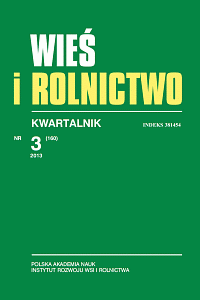Próba charakterystyki społeczno-ekonomicznej obszarów o cechach niekorzystnych dla rozwoju funkcji rolniczej
Testing for socio-economic characteristics in areas with less characteristics of an agricultural development function
Author(s): Jan Jadczyszyn, Andrzej RosnerSubject(s): Economy
Published by: Instytut Rozwoju Wsi i Rolnictwa Polskiej Akademii Nauk
Keywords: rural development; problem agricultural areas; deagrarization of local economy; rozwój obszarów wiejskich; rolnicze obszary problemowe; dezagraryzacja gospodarki lokalnej
Summary/Abstract: The article is based on studies conducted by IUNG (Instytut Uprawy Nawożenia i Gleboznawstwa – Institute of Soil Science and Plant Cultivation) on the subject of delimiting problem areas in agriculture, as well as on studies published by IRWiR PAN (Instytut Rozwoju Wsi i Rolnictwa Polskiej Akademii Nauk – Institute of Rural and Agricultural Development of the Polish Academy of Sciences) focusing on the spatial differentiation of rural areas with regard to socio-economic development. The analyses of IUNG are based on agro-technical terminology, while those of IRWiR PAN employ socio-economic terms. An analysis of the results of both sets of studies indicates that some areas considered problematic for agriculture are less advanced with regard to the level of socio-economic development and the dynamics of transformations. However, this is the case mainly in the lowlands – in the highland and sub-mountain regions most problem areas in agriculture typically present a relatively high degree and dynamics of socio-economic development. In these areas the agricultural economic function is undergoing gradual reduction in favour of other functions, including tourism and recreation. In problem areas in agriculture situated in the lowlands, such processes of deagrarianization of economic structures are relatively less advanced to a large degree. This currently leads to a decline in population of some of these areas, as well as to other unfavourable phenomena typical of depopulation in some of them. The current instruments of cohesion and agricultural policy (including income redistribution towards agriculture in less favoured areas) cannot counteract the spatial stratification processes in rural areas. Artykuł oparty został na wynikach badań prowadzonych w IUNG-PIB, dotyczących delimitacji obszarów problemowych rolnictwa, oraz w IRWiR PAN, skupiających się na przestrzennym zróżnicowaniu obszarów wiejskich pod względem społeczno-gospodarczym. Analiza uzyskanych wyników tych badań wskazuje, że część obszarów problemowych z punktu widzenia rolnictwa to obszary zapóźnione pod względem poziomu rozwoju społeczno-gospodarczego oraz dynamiki zachodzących przemian. Jednak dotyczy to głównie obszarów nizinnych. W terenach górskich i podgórskich większość obszarów problemowych z punktu widzenia rolnictwa charakteryzuje się relatywnie wysokim poziomem i dynamiką rozwoju społeczno-gospodarczego. Na obszarach tych rolnicza funkcja gospodarcza jest stopniowo redukowana na rzecz innych funkcji, w tym turystycznej i rekreacyjnej. Tego rodzaju proces dezagraryzacji struktury gospodarczej obszarów problemowych rolniczych na terenach nizinnych jest relatywnie znacznie słabiej zaawansowany. Obecnie prowadzi to do zmniejszania się zaludnienia tych obszarów, a w części z nich do niekorzystnych zjawisk charakterystycznych dla obszarów depopulacyjnych.
Journal: Wieś i Rolnictwo
- Issue Year: 160/2013
- Issue No: 3
- Page Range: 75-92
- Page Count: 18
- Language: Polish

